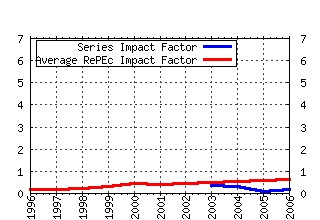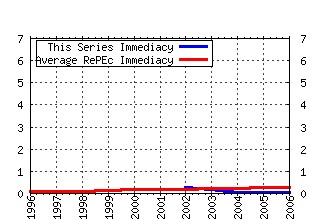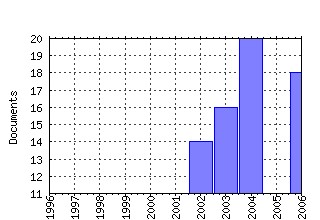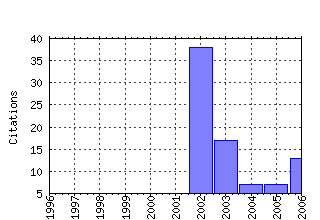
|
|
||||||||||||||||||||||||||||||||||||||||||||||||||||||||||||||||||||||||||||||||||||||||||||||||||||||||||||||||||||||||||||||||||||||||||||||||
Asian Economic Papers Raw citation data, Impact Factor, Immediacy Index, Published documents, Citations received, , Most cited papers , Recent citations and documents published in this series in EconPapers.
Most cited documents in this series: (1) RePEc:tpr:asiaec:v:1:y:2002:i:1:p:146-197 Geography, Economic Policy, and Regional Development in China (2002). (2) RePEc:tpr:asiaec:v:1:y:2002:i:2:p:133-165 Macroeconomic Policy in Japan (2002). (3) RePEc:tpr:asiaec:v:1:y:2002:i:3:p:32-62 Understanding Regional Economic Growth in India (2002). (4) RePEc:tpr:asiaec:v:4:y:2005:i:3:p:1-27 Product Fragmentation and Trade Patterns in East Asia (2005). (5) RePEc:tpr:asiaec:v:2:y:2003:i:3:p:30-56 How Do Global Credit-Rating Agencies Rate Firms from Developing Countries? (2003). (6) RePEc:tpr:asiaec:v:2:y:2003:i:3:p:1-20 Trade Integration and Business Cycle Synchronization in East Asia (2003). (7) RePEc:tpr:asiaec:v:5:y:2006:i:2:p:32-72 Correlation, Contagion, and Asian Evidence (2006). (8) RePEc:tpr:asiaec:v:3:y:2004:i:3:p:182-201 Regional Versus Global Risk Sharing in East Asia (2004). (9) RePEc:tpr:asiaec:v:2:y:2003:i:2:p:1-38 The Consequences of Chinas WTO Accession for Its Neighbors (2003). (10) RePEc:tpr:asiaec:v:5:y:2006:i:1:p:142-176 An Assessment of the Usefulness of Money for Policy in the Philippines (2006). (11) RePEc:tpr:asiaec:v:5:y:2006:i:1:p:73-89 Financial Market Integration in East Asia: Regional or Global? (2006). (12) RePEc:tpr:asiaec:v:1:y:2002:i:2:p:110-126 The Current State of the Japanese Economy and Remedies (2002). (13) RePEc:tpr:asiaec:v:3:y:2004:i:2:p:126-157 The Post-reform Performance of the Manufacturing Sector in India (2004). (14) RePEc:tpr:asiaec:v:2:y:2003:i:1:p:53-80 Financial Markets, Institutions, and Integration in East Asia (2003). (15) RePEc:tpr:asiaec:v:1:y:2002:i:3:p:90-119 Structural Adjustment Program after Structural Adjustment Program, but Why Still No Development in the Philippines? (2002). (16) RePEc:tpr:asiaec:v:1:y:2002:i:2:p:75-103 What Would Have Happened in Indonesia if Different Economic Policies Had Been Implemented When the Crisis Started? (2002). (17) RePEc:tpr:asiaec:v:5:y:2006:i:1:p:1-32 Purifying Japans Banks: Issues and Implications (2006). (18) RePEc:tpr:asiaec:v:2:y:2003:i:2:p:46-73 Malaysias Response to the China Challenge (2003). (19) RePEc:tpr:asiaec:v:5:y:2006:i:2:p:7-29 The Evolution of Exchange Rate Policy and Capital Controls in Australia (2006). (20) RePEc:tpr:asiaec:v:5:y:2006:i:1:p:92-134 The Global Macroeconomic Consequences of a Demographic Transition (2006). (21) RePEc:tpr:asiaec:v:2:y:2003:i:3:p:87-126 On Alternatives to Aggressive Demand Policies to Revitalize the Japanese Economy (2003). (22) RePEc:tpr:asiaec:v:2:y:2003:i:2:p:145-180 Regionalism and Free Trade Agreements in East Asia (2003). (23) RePEc:tpr:asiaec:v:6:y:2007:i:1:p:46-71 Who Pays Chinas Bank Restructuring Bill? (2007). (24) RePEc:tpr:asiaec:v:1:y:2002:i:1:p:91-128 What Kind of International Financial Architecture for an Integrated World Economy? (2002). (25) RePEc:tpr:asiaec:v:3:y:2004:i:2:p:49-70 Deciphering the Message in Japanese Deflation Dynamics (2004). (26) RePEc:tpr:asiaec:v:2:y:2003:i:1:p:85-136 Can Information and Communication Technology Solve Japans Productivity Slowdown Problem? (2003). (27) RePEc:tpr:asiaec:v:3:y:2004:i:2:p:1-40 Famine and Reform in North Korea (2004). Recent citations received in: | 2006 | 2005 | 2004 | 2003 Recent citations received in: 2006 (1) RePEc:iis:dispap:iiisdp176 Shift versus traditional contagion in Asian markets (2006). IIIS / The Institute for International Integration Studies Discussion Paper Series Recent citations received in: 2005 Recent citations received in: 2004 (1) RePEc:hhs:gunwpe:0122 Can Japan Make a Comeback? (2004). Göteborg University, Department of Economics / Working Papers in Economics Recent citations received in: 2003 (1) RePEc:eab:tradew:373 Taiwans Role in the Economic Architecture of East Asia and the Pacific (2003). East Asian Bureau of Economic Research / Trade Working Papers (2) RePEc:imf:imfwpa:03/81 Trade, Finance, Specialization, and Synchronization (2003). International Monetary Fund / IMF Working Papers (3) RePEc:tky:fseres:2003cf222 Does Natural Selection Mechanism Still Work in Severe Recessions'DONE' --]Examination of the Japanese Economy in the 1990s --- (2003). CIRJE, Faculty of Economics, University of Tokyo / CIRJE F-Series Warning!! This is still an experimental service. The results of this service should be interpreted with care, especially in research assessment exercises. The processing of documents is automatic. There still are errors and omissions in the identification of references. We are working to improve the software to increase the accuracy of the results. Source data used to compute the impact factor of RePEc series. |
||||||||||||||||||||||||||||||||||||||||||||||||||||||||||||||||||||||||||||||||||||||||||||||||||||||||||||||||||||||||||||||||||||||||||||||||




